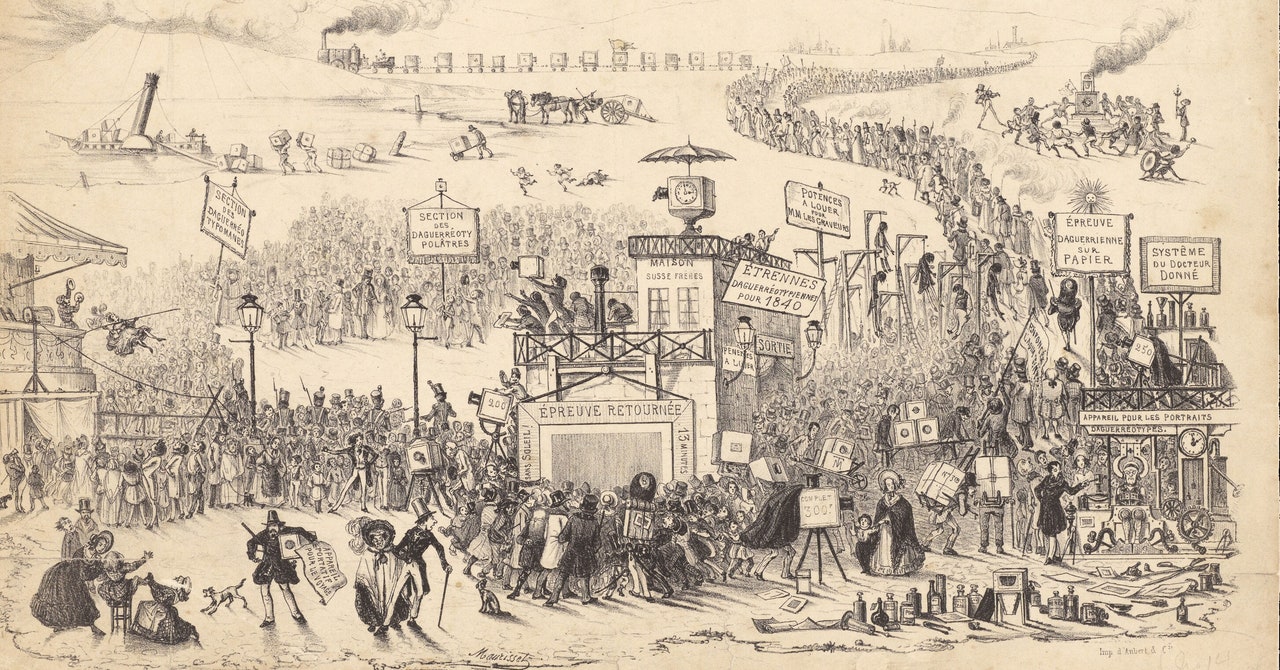There’s a hilarious illustration from Paris in late 1839, mere months after an early type of photograph called a daguerreotype was announced to the world, that warned what this tiny picture portended. In Théodore Maurisset’s imagination, the daguerreotype would bring about a collective hysteria, La Daguerréotypomanie, in which crazed masses arrive from the ends of the earth and overrun a small photo studio. Some in the crowd want pictures of themselves, but, mon Dieu, others demand cameras to take their own pictures—Maurisset shows them loading the machines like contraband onto steamships bound for foreign ports—and still others throng simply to ogle at this newfangled thing and all the lunatic proceedings surrounding it. The clamor is so feverish that it brings about a mass hallucination, in which nearly everything else in the landscape around the studio, including railroad cars, a clock tower, a basket for a hot air balloon, indeed anything remotely boxy in shape, morphs into cameras. As they march to the studio, the crowds pass by half a dozen gallows, where in response to the daguerreotype’s appearance artists have hung themselves. The people hardly notice.
What a ruckus! What panic! And why not? Until the appearance of photography, painters had nearly a monopoly on artistic representation. Their craft was regarded as the primary means to concoct images. (Of course, printmakers and illustrators had their own ideas about the worth of their pictures, but painters usually thought of them more like lesser cousins.) But now those silly photographers, most of whom were rank amateurs or, worse, disloyal or failed artists, would get the job. Upon seeing a daguerreotype for the first time around 1840, the French painter Paul Delaroche, whose own students would soon defect to photography, was said to have cried out, “From today, painting is dead!”
The history of painting’s early relationship with photography is not perfectly analogous to the conundrum caused by today’s AI-made art. Image generators like DALL-E 2, Midjourney, and Stable Diffusion can riff on an existing painting in ways no camera could come close to. But compare Delaroche’s exclamation to the crowing of Jason Allen of Pueblo West, Colorado, who last September took home first prize for his AI-generated entry in an art competition at the annual state fair. The $300 prize was modest, yes, but that didn’t stop Allen from gloating. “Art is dead, dude,” he said afterward. “It’s over. AI won. Humans lost.” New tools often have a way of stoking grand claims about their impact, and they also give us a chance to consider whether history has anything to teach us about the prognosis for them.
In the 19th century, painting, at least, did not die. Or even suffer a mild cold. Painters did not lose jobs, and Delaroche himself went on to paint some of his most monumental and ambitious work. I suspect he was never truly concerned about being replaced, and he and others played up the anxiety because it was juicy gossip, a chance to bellyache about the tastelessness or just plain vulgarity of critics, and actually good for business.
Still, Maurisset’s vision of the masses rampaging the landscape was not totally wrong. The number of people who wanted to sit before the camera or sought cameras for themselves were not only countless but diverse. They were generally of a very different group of patrons than those supporting painters, tending to be from the middle and working classes, whose previous ability to buy or make images was almost nil. During an age that also included reforms to expand the vote, early activism for women’s rights, and the abolition (first in the UK, then in the US) of slavery, the camera acquired something of a democratic air. Frederick Douglass, the great abolitionist and former slave, was so taken with its possibilities that during his lifetime he had more than 160 different portraits made of himself—more than any other American in the 19th century—in the belief that through them he could insist on his self-worth and dignity. The camera was potentially everybody’s tool (it wasn’t exactly, but that was the promise to sitters like Douglass), and such a thing had rarely been said about painting.
In those early days, the two media tended to have different markets; painters reaffirmed and photographers had difficulty penetrating the exclusiveness in both the training and exhibition of the fine arts. Even the most skilled and art-minded photographers were always fighting the lowly status accorded their craft by the art establishment. Whereas painting as a studio practice became a standard college offering as early as the 1860s (at least in New England), it took photography another 75 years to find a tenuous footing in higher education. It was not until the 1930s that art museums began regularly buying and showing photographs.



